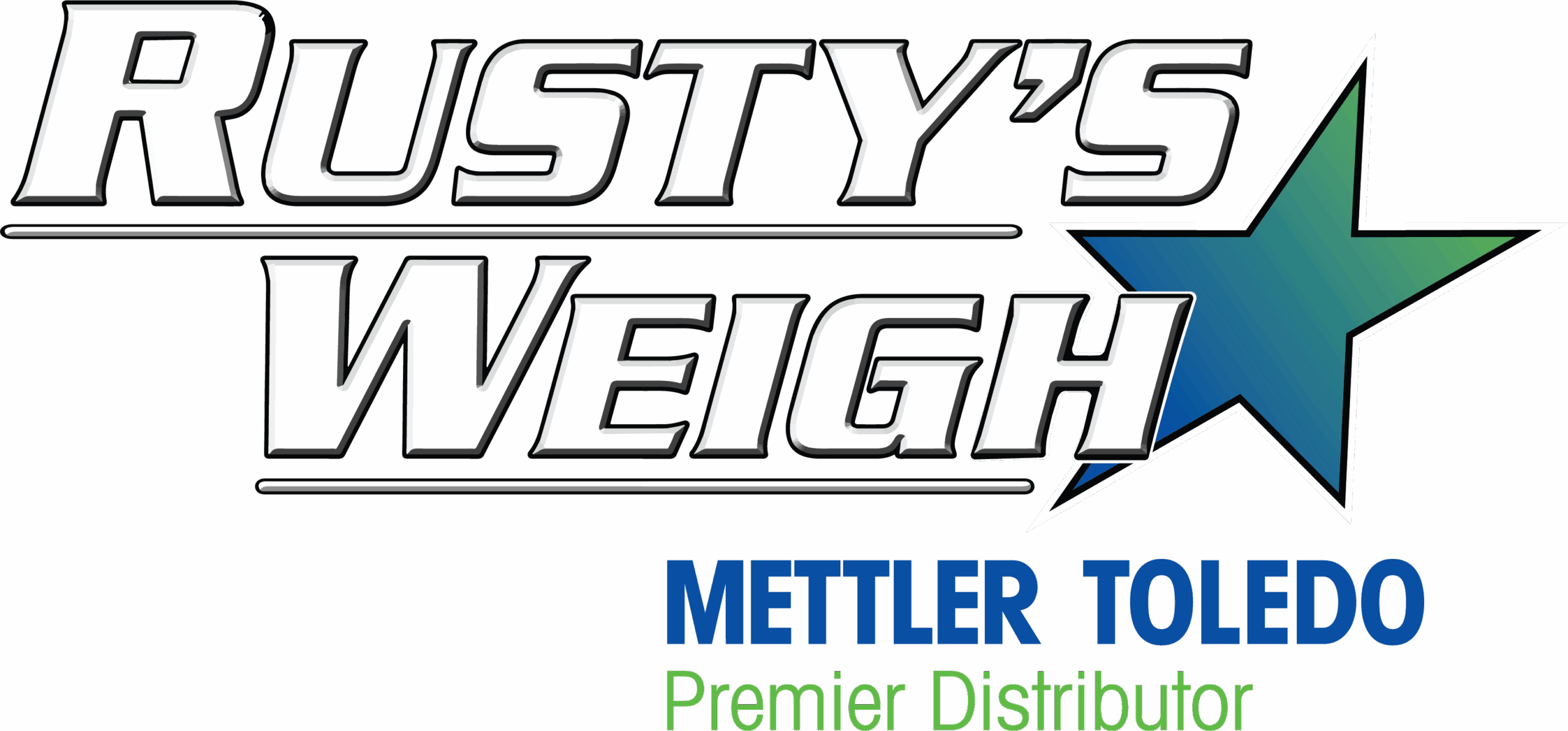
Buying a scale is often made more difficult by confusing terms and industry jargon. It is our hope that the following list of scale terminology helps you in your scale buying process. Additionally, Rusty’s Weigh has qualified representatives who would be happy to walk through any questions you might have.
A:
Accumulation- A weighing function that allows the device to total multiple weighing results.
Accuracy– The ability of the weighing system to repeat with each weighment and weight display of the reading compared to known weights repeated.
Ambient Conditions- The environmental conditions (temperature, humidity, pressure, temperature, etc.) of the area surrounding the load cell.
Analytical Balance- A balance that weighs very small quantities in very tiny increments. Usually refers to sub-milligram weighing results.
B:
Backlit Display- The Liquid Crystal Display (LCD) of some balances is designed to have a backlight for easy reading of weighing results.
C:
Calibration – The comparison of load cell voltage outputs against standard test loads.
Capacity– Maximum amount of weight the scale is capable of weighing accurately.
Check Weighing– The process of verifying the quality of an end product by its weight
Corner load– differences displayed on an instrument’s weight readings on a given object when placed on the corners of the weighing pan.
Creep- Change that takes place in load cell output while under load, and with all environmental conditions and other variables remaining constant. Creep usually is measured with rated load applied and expressed as a percent of rated output over a specific duration.
D:
Divisions– The number of increments viewable on a scale.
Drift– A continuously change in the numbers displayed on the digital readout, either upward or downward. Commonly caused by temperature, static electricity or radio frequency interference.
Dynamic Weighing- A mode featured on some balances and scales for weighing moving animals or measuring fluid samples. The device works out an average weight based on the force exerted by the animal or sample over an extended period of time. Once the internal calculation is completed by the balance, it will hold the value.
E:
External Calibration- The calibration process of a balance using a known external weight often referred to as suggested calibration weight.
F:
Factory Mutual (FM) System Approved– The symbol stating that products are approved for use in classified/hazardous locations when following the proper installation procedures and utilizing intrinsic safety barriers.
Force Restoration- A method to determine an unknown mass by balancing the force due to the mass with another force created by the system using coils mounted in a magnetic field. Also called Servo motor or force motor.
Formulation- Formulation, also referred to as the recipe calculation function, is a selectable weighing mode on precision and analytical balances that allows the user to easily store, add and calculate the weight of multiple ingredients in order to provide a total weight value.
H:
Hermetically Sealed– Load cells protected for use in harsh chemical or wash-down environments. These load cells have a metallic protective cover welded or soldered in place to protect the strain gauge cavity. Some cells of this type have additional protection at the cable entry such as a glass-to-metal seal.
I:
Increment- These terms are often used interchangeably to indicate how well a scale displays the correct results. Increment is the value of the finest division of the scale. See also: Accuracy, Readability, Resolution
Indicator- Device on which weighing or counting results are displayed. The scale or balance often can be programmed for a variety of applications and weighing units using software accessed via the indicator.
Interface– A device or circuit that allows two units to communicate. Some of the standard interfaces used in the scale industry are 20 mA current loop RS-232 ID NET.
Intrinsically Safe System- equipment which is incapable of releasing sufficient electrical or thermal energy under normal or abnormal conditions to cause ignition of a specific hazardous atmospheric mixture in its most easily ignited concentration.
IP Ratings (Ingress Protection)- The degrees of protection provided against the intrusion of solid objects (including body parts like hands and fingers), dust, accidental contact, and water in electrical enclosures as defined in international standard IEC 60529.
J:
J-BOX (Junction Box)- A box or enclosure used to join different runs of cable. These contain space and terminals for connecting and branching the enclosed conductors and adjustments to provide load cell trimming. Can often retain moisture, dirt, and debris which will affect weighing of the scale.
L:
Leveling
The procedure to set the balance so the platform is horizontal. This gives the balance a position that is repeatable so the results will be the same if the balance is moved. This is done using levelling feet.
Linearity– Refers to the quality of delivering identical sensitivity throughout the weighing capacity of a scale or balance.
Load– The weight or force applied to the load cell.
Load Cell– A device which produces an electrical output signal proportional to the applied weight or force of an object.
M:
Mass – The amount of matter in an object. Big things are generally more massive than small ones.
Measurement Uncertainty – The rounding error, unable to be displayed, in any value attributed to a measured quantity.
Moisture Analyzer/Moisture Balance- A weighing device that quickly measures samples before and after drying to determine moisture levels. Suitable for a variety of industries, moisture analyzers are used in product development labs to test foods and pharmaceuticals, or to assess the moisture content in sludge during the wastewater treatment process.
Moisture Determination- Balance function that calculates moisture percentage by comparing an initial sample weight to the same sample’s weight after drying.
N:
Net Total Formulation- Balance function that automatically adds the individual weights of several components and displays the total.
Net Weight- Weight of the load on the pan minus the container (tare) weight.
NTEP (National Type Evaluation Program)- A partnership program between the National Conference On Weights & Measures, NIST, state weights and measures officials and the private sector for determining conformance of weighing equipment with the provisions of Handbook-44.
O:
Off-center Loading- The ability to display the same value when a weight is placed anywhere on the weighing platform. Tested by weighing in the center of 4 quadrants on the platform. Also called eccentric loading or shift test.
Overload Ratings- The maximum load which can be applied without producing a permanent shift in the device’s performance.
P:
Parameter- A set of procedures that can be followed to change the characteristics of a balance. The menu is made up of a number of options, called parameters, that can be set at the factory or in some cases by the user. See also: Menu
Parts Counting- Using a scale to determine the number of parts placed on the platform based upon the average piece weight. the piece weight is either entered by the user or determined by weighing a sample on the scales.
Percent Weighing- Using a balance to determine the weight of an item as a percentage of a reference weight.
Precision Balance- A balance used to weigh quantities to a very precise number, usually up to one milligram. Precision balances come in a wide variety of capacities and pan sizes.
R:
Repeatability– The weighing system’s ability to display a consistent weight reaching each and every time.
Resolution– The smallest incremental change in weight that can be displayed by a weighing system
T:
Tare– The weight of an empty container or vehicle. Often deduction from the gross weight.
Tolerance– The amount of error that is allowed in a weighing.
Traceability – The property of a measurement result relative to suitable nationally or internationally applicable standards. Often in reference to the unbroken chain of comparative measurements with specified measurement uncertainties.
W:
Weighing Units- The balance can be set to display the weight of an unknown mass in various weighing units such as Grams, Kilograms, Milligrams, Pounds, Ounces, Carats, Grains, Newtons, etc.
Z:
Zero- To set the display to show zero weight. Used to reset the zero condition of a scale when small amounts of material are on the platform. Zero does not take away from the capacity of a scale. However it will only work in a very small range around the original zero condition for the scale. Zero and Tare are often combined on one key, the terms are often used interchangeably.


